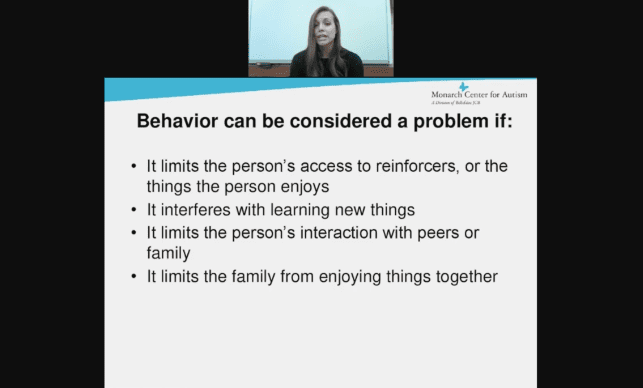Strategies for Challenging Behaviors of Students with Autism
“Every individual should be able to access things that they like,” said Monica Fisher, M.Ed., BCBA/COBA, Director of the Behavior Department at Monarch Center for Autism during an edWebinar. “It is our right to engage in preferred activities, spend time with family, and connect with the community. If there are behaviors that you are seeing in your students with disabilities and challenging behaviors that are limiting these rights, then it is something we need to fix as it can have a long-term impact on their quality of life.”
Applied Behavior Analysis (ABA), a technological and professional systematic approach, is designed to analyze and change behavior by identifying a behavioral problem, gathering relevant data, and formulating/testing a hypothesis. Fisher said that while ABA is a useful tool for looking at and changing the challenging behaviors of students with autism, it can apply to different parts of everyone’s lives. “ABA is how we have all learned and how our lives are shaped by behavior.”
Three-Term Contingency or ABC (Antecedent-Behavior-Consequence) goes hand in hand with Applied Behavioral Analysis. ABC is an essential, evidence-based method of examining and changing what people say and do. Fisher explained, “If you want to change behavior, you have to look at the antecedent (action, event or circumstance that occurs immediately before the behavior) and the consequences (action or response that immediately follows the behavior) applied.”
Challenging Behavior
Challenging behaviors in the form of hitting, kicking, biting, and head-banging are not unique to students with autism. However, students with autism can also display challenging behaviors through physical and verbal aggression, self-injury, elopement, property destruction, tantrums, and non-compliance. According to ABA literature, there are four main functions of challenging behavior: attention, escape, access to tangibles and automatic/sensory.
Fisher expounded that it is essential to understand that all behaviors serve a function and they will persist if they are meeting a need for a student. When a student receives attention after a problem behavior, it may increase the likelihood that the problem behavior will occur in the future under similar circumstances.
When an individual engages in challenging behavior, it could be to escape or postpone an aversive event such as classwork or to be given access to tangibles and other reinforcing objects such as more computer time. The challenging behavior of automatic/sensory such as rocking or hand slapping may reinforce on their own and does not depend on the actions or presence of others.
Important to Remember
There are essential skills relating to the functions of behavior that should be taught to children at a young age that could decrease the chances that challenging behaviors will develop. Challenging behaviors can have a long history of reinforcement, making them resistant to change, so Fisher advises that changes will take time and effort, and data will play a significant role in analyzing the behavioral changes. A teacher or parent may feel that the reinforcers for changing the challenging behavior are not sufficient, but once the data is analyzed, it may show that there is a slight change in the action.
It is also critical that, when initially teaching a replacement behavior, the new skill needs to be low effort and reinforced every time with a potent reinforcer. Finally, problem behavior has worked in the past to get the individual what they want or need so it is essential for teachers and parents to remember not to personalize a student’s challenging behavior.
This edWeb broadcast was sponsored by Monarch Center for Autism, STAR Autism Support, and VizZle.
This article was modified and published by eSchool News.
About the Presenter
Monica Fisher, M.Ed., BCBA/COBA has more than 15 years of experience working with children on the autism spectrum in home, school and residential settings. She provides in-home consultative services for families in the community, and has provided trainings for parents, teachers and other professionals. She is currently the director of the behavior department at Monarch Center for Autism and is responsible for managing a team of behavior specialists and BCBAs. Monica earned her bachelor’s degree in psychology from the College of Wooster, her master’s degree and intervention specialist licensure from Cleveland State University, and she took coursework in applied behavior analysis through Florida Institute of Technology. She previously served as an intervention specialist in Monarch’s High School, and was formerly an associate teacher at Monarch School. She is also an independent behavioral consultant for ABA Outreach Services, providing behavioral consultative services for families of children with autism.
Join the Community
Teaching Students with Autism is a free professional learning community on edWeb.net that provides ideas and resources for teachers working with students with autism, particularly advances in technology that can lead to significant breakthroughs in communication and learning.








Comments are closed.